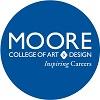The College of Art, Media & Design at the University of the Arts (UArts) houses the School of Design, which offers BFA degrees in Graphic Design and Illustration. The Illustration BFA is cross-disciplinary, so students will work with other students in majors such as Graphic Design, Product Design, Interaction Design, Fine Arts, and Animation. In addition to training students in industry software such as After Effects, Illustrator, Adobe Photoshop, and InDesign, the Illustration BFA curriculum explores typography, traditional and experimental painting methods, anatomy, and developing narratives. Specialized graphic design courses are also part of the program.
Graduates of the UArts Illustration BFA Program have worked with The New Yorker, Random House, ESPN, Rolling Stone, The New York Times, Fortune, and Ralph Lauren, among others.
The UArts Graphic Design BFA is a 120 credit hour cross-disciplinary program that provides collaboration and networking opportunities with local non-profits, social agencies, and arts organizations. Course examples include Drawing as Seeing and Meaning, Typography I-III, Design History, Digital Design Lab, Design for Persuasive Visual Communication, Real World Design, Image and Narrative, Design for Interaction, School of Design Workshop, and Editorial Systems.
BFA students have the opportunity to complete unpaid and paid internships with major companies and studios such as Cartoon Network, Urban Outfitters, and Sterling Publishing. The program culminates with the Senior Thesis.
Graduates of the UArts Graphic Design Program are prepared for employment in fields ranging from branding and motion graphics to publication design. Students and alumni have worked for NASA, Disney, National Geographic, MTV, ESPN, Meta (formerly Facebook), DreamWorks, ESPN, The Wall Street Journal, Penguin Group Publishing, Hallmark, Harper-Collins, Hasbro, Houghton Mifflin Harcourt, Knopf, Marvel Comics, NASA, 20th Century Fox, Oprah, Warner Bros., Blizzard Entertainment, Newsweek, Simon & Schuster, Nickelodeon, PBS, Time Magazine, and NPR, among others.
University of the Arts is accredited by the Middle States Commission on Higher Education (MSCHE). Founded in 1876 as part of the Philadelphia Museum of Art, University of the Arts serves nearly 1,500 students enrolled in more than 40 degree programs in fine arts, design, media arts, dance, music, theater, and crafts. More than 20 minors are available and open to all students. UArts programs are offered in the Schools of Art, Dance, Design, Film, Music, Theater Arts, and Graduate and Professional Studies.












